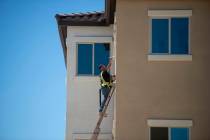Head south for the winter; harvest solar energy
I love winters in Southern Nevada! In fact, just about anytime from October to June is fine by me, but deep winter is special. I suppose it's a stretch to call our relatively mild and brief period of cool weather "deep winter" but hey, it's all we've got.
One reason I like it so much is that I get to harvest my favorite crop: passive solar energy. Turning on the heater has its place, but nothing beats getting some carbon-free warmth from the sun.
Many of us have experienced the pleasure of curling up with a good book near a sunny window on a cold winter day. At the very least, we've noticed how warm our cars can be when parked in the sun even on the coldest of days. This is passive solar energy at work.
It's great to take advantage of it in our homes when possible. All you need are some south-facing windows. Actually, any window that gets direct sunlight can work at some point during the day, but windows that face south can harvest the sun's energy from sunrise to sunset.
If you have drapes, blinds or other window coverings, open them up every morning and let the sun shine in. The low winter sun will penetrate deeply into the space. This energy can add a lot to the comfort of a home in winter. The best scenario is to harvest the energy during the day and store if for use at night, but unless a home is designed specifically for this, it's hard to get good results.
So how do we store solar energy for use after the sun goes down? When sunlight strikes a dark surface heat is absorbed. The more dense the object, the more energy it can store. Thus, a masonry wall or concrete floor can work well as thermal mass. When the sun goes down, the warmth is released slowly back into the room.
Even without thermal mass, we can still harvest solar energy. If a home is well insulated, it will hold the heat well into the night. The key is to keep the warmth from escaping once the sun has gone down. Since most windows are not good insulators, it pays to cover them in the evening. One of the best methods is to use some form of insulating shade or shutter.
Running a passive solar home is analogous to sailing a boat. A sailboat can get us to just about any destination but it requires more knowledge and skill than just turning the key on a powerboat. In the end, the result is the same, but the process of sailing ensures that one is much more engaged in the process, not to mention saving a lot of fuel.
So every morning at our house we hoist the shades (actually we open our insulating shutters) and set forth on a day of harvesting passive solar energy. In the evening, we drop the shades, anchoring for the night and preserving the sun's warmth. It's a simple but effective routine that helps lower our carbon footprint and provides a bit of personal satisfaction as well. Of course we turn on the engine, our furnace, to help us along the way when necessary.
We all must play the hand we're dealt. If you have some south-facing windows and can sail your home a bit, then you are fortunate. For those who may not yet have that opportunity, perhaps you can apply this knowledge the next time you're in the market for a new place to live.
We can all help chart a course for greater use of passive solar energy. Look for homes and communities that are designed with this in mind. If you don't see them, ask for them. Indeed, it's time to demand them. Help educate your elected officials about the benefits of passive solar buildings. It is possibly the greatest lost opportunity of our recent past since it often costs little or nothing to implement and can save so much over time. Homes and buildings that are designed properly can not only be warmer in winter, but cooler in the summer. They require much less energy to maintain at comfortable temperatures.
As responsible citizens, we owe it to the world and to future generations to reduce our profligate consumption of nonrenewable energy. Fossil and nuclear energy damage our environment. Using passive solar energy wisely can effectively mitigate much of this damage. When combined with good insulation, some thermal mass and some solar panels, our homes can become sources of clean energy rather than consuming dirty power from far away smokestacks.
If you don't believe me, just watch a cat on a cold winter day. Cats love to stretch out in front of a warm, sunny window. As Jim Augustyn, author of "The Return of the Passive Solar Cat" says, "Cats know a lot more about solar energy than people do." Isn't it time we learned?
Steve Rypka is a green living consultant and president of GreenDream Enterprises, specializing in renewable energy, green building, alternative transportation and lifestyle choices for both residential and commercial clients. The company is committed to helping people live lighter on the planet. Rypka can be reached via e-mail at steve@greendream.biz. More information relating to this column is posted at www.greendream.biz.

















